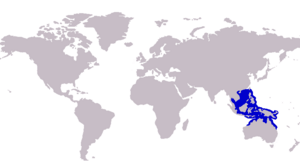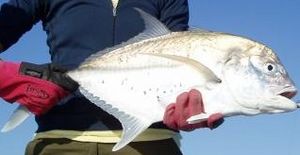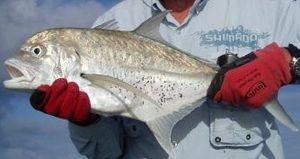Bluespotted trevally facts for kids
Quick facts for kids Bluespotted trevally |
|
|---|---|
 |
|
| Conservation status | |
| Scientific classification | |
 |
|
| Approximate range of the bluespotted trevally |
The bluespotted trevally (Caranx bucculentus) is a type of moderately large fish that lives in the ocean. It belongs to the jack family, called Carangidae. This fish gets its name from the dark blue spots on its upper body. It's also sometimes called the wide-mouthed trevally because of its mouth shape.
You can find the bluespotted trevally in the warm, tropical waters of the eastern Indian Ocean and western Pacific Ocean. Its home ranges from Taiwan in the north down to Australia in the south. These fish prefer to live close to shore in sandy, muddy, or seagrass areas, often found in large bays.
The bluespotted trevally is a predator. When young, it eats small crustaceans like crabs and prawns. As it grows bigger, its diet changes to mostly include other fish. In northern Australia's Gulf of Carpentaria, it's a very common predator, especially of prawns that are important for fishing. These fish can grow up to 66 cm long. They are often caught by accident in prawn fisheries but are not usually kept for food.
Contents
What is a Bluespotted Trevally?
The bluespotted trevally is part of a group of fish known as jacks or trevallies, all within the genus Caranx. This genus is part of the bigger jack and horse mackerel family, Carangidae.
Two Australian zoologists, Haynes Gibbes Alleyne and Sir William John Macleay, first described this fish scientifically in 1877. They found a specimen near Cape Grenville, Queensland. They named it Caranx bucculentus. The word bucculentus comes from Latin and means 'with full cheeks', which refers to the fish's wide mouth. The name 'bluespotted trevally' is used because of the blue spots on its body.
How to Identify a Bluespotted Trevally
The bluespotted trevally is a medium-sized fish, growing up to about 66 cm long. It has a body shape typical of many larger Caranx species: it's quite flat from side to side and has an oblong shape. Its back (dorsal side) is more curved than its belly (ventral side).
This fish has two dorsal fins on its back. The first one has eight stiff spines, and the second has one spine and 18 or 19 soft rays. The anal fin on its underside has two separate spines at the front, followed by one spine and 15 to 17 soft rays. The pelvic fins have one spine and 18 soft rays.
A key feature is its lateral line, which is a sensory line along its side. It has a very strong curve at the front, then becomes straight. The straight part is more than 2.5 times longer than the curved part. The curved part has 40 to 50 scales, while the straight part has 33 to 39 strong, bony plates called scutes. The area on its chest below the belly is bare, without scales. Its eyes have a well-developed fatty eyelid. The upper jaw has strong outer canine teeth and an inner band of brush-like teeth. The lower jaw has a single band of cone-shaped teeth.
The bluespotted trevally is generally a pale olive green on top, fading to a silvery white underneath. Adult fish have many small blue spots on the upper half of their bodies. There's a large dark spot near the top of its gill cover and a black spot at the base of its pectoral fins. All its fins are yellowish-green.
Where Do Bluespotted Trevallies Live?
The bluespotted trevally lives in the warm, tropical waters of the East Indian and West Pacific Ocean. Its range is smaller than many of its relatives. You can find them from the South China Sea near Taiwan and Borneo, south through eastern Indonesia, and the Arafura Sea around Papua New Guinea. They are very common off northern Australia, especially in the Gulf of Carpentaria. Sometimes, they are seen as far south as Gladstone, Queensland.
These fish are inshore species, meaning they live close to the coast. They prefer shallow bays with sand, mud, or sometimes seagrass bottoms. They can also be found in slightly deeper bay waters. Studies show they are most common at depths around 28.1 meters.
Life and Habits of the Bluespotted Trevally
Scientists have studied the bluespotted trevally quite a bit, especially after finding out how common and important they are in the shallow water ecosystems of northern Australia. They are one of the top ten most common secondary consumers (animals that eat other animals) in these areas. They are also the most important predator of prawns that are caught for food.
Bluespotted trevallies are predatory fish. They eat a variety of crustaceans and other fish. Studies in the Gulf of Carpentaria show that these fish are most common where prawns live. Their diet changes as they get older. Young fish (less than 275 mm long) eat prawns, crabs, other crustaceans, echinoderms, and molluscs. Larger fish mostly eat small fish. Their diet doesn't seem to change much with the seasons.
Bluespotted trevallies become ready to reproduce when they are about 110 mm long, usually after their first year of life. This is earlier than other fish in the Caranx group. They lay eggs all year round in the Gulf of Carpentaria, with a peak in spring. A female can release between 18,000 and 650,000 eggs during spawning. These fish grow at a rate of about 82.2 mm per year.
Bluespotted Trevally and Humans
Even though there are many bluespotted trevallies, especially in northern Australia, there isn't a big fishery just for them. They are often caught by accident in trawl nets used for prawns. However, they are usually thrown back into the ocean because they are not considered good to eat. Also, larger ones might cause ciguatera poisoning, which is a type of food poisoning from eating certain reef fish.
Sometimes, recreational fishermen catch bluespotted trevally using lures and baits. They are considered a good sport fish to catch. However, they are not as famous as other trevally species like the giant trevally or bluefin trevally.
See also
 In Spanish: Caranx bucculentus para niños
In Spanish: Caranx bucculentus para niños




